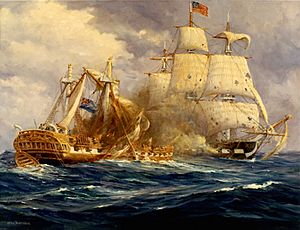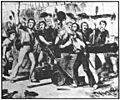USS Constitution vs HMS Guerriere facts for kids
Quick facts for kids USS Constitution vs HMS Guerriere |
|||||||
|---|---|---|---|---|---|---|---|
| Part of the War of 1812 | |||||||
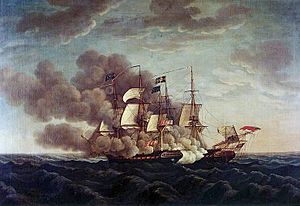 USS Constitution vs HMS Guerriere by Michele Felice Cornè |
|||||||
|
|||||||
| Belligerents | |||||||
| Commanders and leaders | |||||||
| Strength | |||||||
| 1 44-gun Frigate 56 guns 754lb broadside 480 U.S. Navy Sailors and U.S. Marine infantry |
1 38-gun Frigate 44 guns 526lb broadside 272 Royal Navy Sailors and Royal Marine infantry |
||||||
| Casualties and losses | |||||||
| 7 killed 7 wounded |
15 killed 78 wounded 257 captured 1 Frigate sunk |
||||||
The USS Constitution vs HMS Guerriere was a famous naval battle. It happened between an American warship and a British warship. This fight took place during the War of 1812. The battle was on August 19, 1812, far out in the Atlantic Ocean.
One month before this battle, the war had just begun. The British ship Guerriere was heading to Halifax, Canada, for repairs. It had been part of a group of ships that tried to catch Constitution earlier. When the two ships met, Captain James Richard Dacres of Guerriere decided to fight. He was sure he could win, even though the American ship was bigger.
However, the Constitution was stronger. Its powerful cannons damaged Guerriere's masts, leaving the ship unable to fight. The American crew rescued the British sailors. Then, they set Guerriere on fire because it was sinking. The Constitution returned to Boston with news of its victory. This win was very important for American spirits during the war.
Contents
Why the Battle Happened
When the United States declared war on Britain in June 1812, the Royal Navy (Britain's navy) was huge. It had 85 ships in American waters. In contrast, the United States Navy was quite new, less than 20 years old. It had only 22 ships ready for battle. Most of its power came from a group of three large frigates and two smaller sloops. These ships were based in New York City.
The U.S. Secretary of the Navy, Paul Hamilton, ordered Captain Isaac Hull of the USS Constitution to join the main American fleet. But the main fleet's commander, John Rodgers, sailed out quickly. He wanted to catch British ships before they could gather. Rodgers did meet a British frigate, but it got away. He then sailed across the Atlantic, hoping to find British merchant ships. He only captured a few small ones.
When the British learned about this, they sent a group of ships to find Rodgers. This forced the British to gather their ships in one place. This allowed many American merchant ships to reach port safely.
The Chase for Constitution
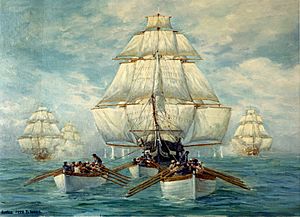
When the war started, the Constitution was in Annapolis, Maryland. It was getting a new crew. It couldn't sail for three weeks. When Captain Hull finally set sail, he headed for New York. On July 17, 1812, he saw five ships. He thought they might be friendly American ships. But he was careful. He kept his distance and waited for daylight.
One of the ships was Guerriere, rejoining the British group. Captain Dacres of Guerriere soon realized Constitution was an enemy. But at dawn, he saw the other four British ships. He thought they were the entire American fleet. So, he also tried to get away, missing a chance to trap Constitution.
The wind was very light, sometimes stopping completely. The Constitution was being chased by the British ships. To move faster, both sides used boats to tow their ships. Hull even ordered ten tons of drinking water to be pumped overboard to lighten his ship. Still, the British were gaining.
Then, Hull's First Lieutenant, Charles Morris, suggested a trick called kedging. This means dropping an anchor far ahead and then pulling the ship forward using the anchor rope. This helped Constitution pull away. Hull also moved some heavy cannons to the back of his ship. He fired them to stop the British from trying the same trick. Later, the wind picked up, and Constitution sped away. The chase lasted for two more days and nights until the British ships were out of sight.
After escaping, Hull sailed to Boston for more water. Then, he went to raid British merchant ships. He later met an American privateer (a private armed ship) whose captain told him he had just escaped a British frigate. This was Guerriere.
Meanwhile, the British commander, Broke, had escorted a valuable group of merchant ships to safety. Three weeks after losing Constitution, he prepared to return to New York. He sent Guerriere to Halifax for much-needed repairs.
The Battle Begins
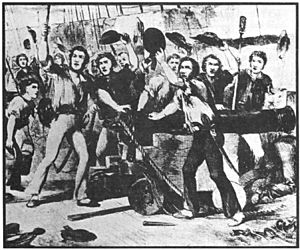
At 2:00 p.m. on August 19, the Constitution spotted a large ship. The weather was cloudy, and the wind was strong. The ship turned out to be Guerriere. Both crews recognized each other at the same time. They prepared for battle, reducing their sails to "fighting sail."
As Constitution got closer, Captain Dacres of Guerriere stopped his ship to fire a broadside (all the cannons on one side of the ship). But his shots fell short. Then, Guerriere sailed away for 45 minutes with Constitution following close behind. Dacres turned his ship several times to fire more broadsides. But Guerriere's shots were not accurate. The few shots from Constitutions front guns also did little damage. After one cannonball bounced harmlessly off Constitutions side, a crew member reportedly yelled, "Huzzah! Her sides are made of iron!" This is how Constitution earned its nickname, "Old Ironsides."
When the ships were only a few hundred yards apart, Captain Hull ordered more sails to be set. He wanted to close the distance quickly. Dacres did not do the same. The two ships began firing broadsides at very close range. Constitution was on the right side of Guerriere.
After 15 minutes, Guerriere was much more damaged. This was because Constitution had bigger guns and a thicker hull. Guerrieres mizzenmast (the mast closest to the back of the ship) fell overboard. It acted like a rudder, spinning the ship around. This allowed Constitution to cross in front of Guerriere. Constitution fired a "raking broadside" (shooting along the length of the enemy ship). This brought down Guerrieres main yard (a long beam on the main mast).
Hull then "wore ship" (turned the ship around) to cross Guerriere's front again. He fired another raking broadside. But the turn was too close. Guerrieres bowsprit (a pole sticking out from the front of the ship) got caught in Constitutions rigging.
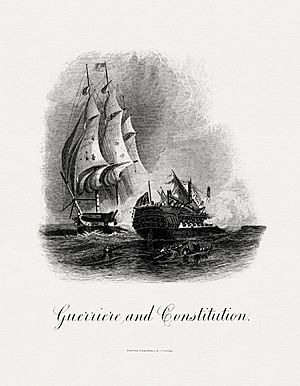
Both ships called for boarding parties (crews ready to jump onto the enemy ship). Musket fire broke out. On Constitution, Lieutenant William S. Bush was killed, and Lieutenant Charles Morris was wounded. Captain Dacres was also wounded. The ships were too close and the sea was too rough for anyone to cross. Some of Guerriere's gunners fired into Hull's cabin, briefly setting the American ship on fire.
The two locked ships slowly spun until they broke free. Then, Guerriere's foremast (front mast) and mainmast (middle mast) both snapped off. This left her helpless and rolling heavily. Dacres tried to use a small sail on the bowsprit to move his ship, but it was also broken. The Constitution sailed downwind for a few minutes, fixing its ropes. Then, it turned around to return to the battle.
As Constitution prepared to fire again, Guerriere fired a shot away from Constitution. Hull understood this was a sign of surrender. He sent a lieutenant to the British ship. When the lieutenant asked if Guerriere was surrendering, Captain Dacres replied, "Well, Sir, I don't know. Our mizzen mast is gone, our fore and main masts are gone - I think on the whole you might say we have struck our flag."
After the Battle
Captain Dacres was brought aboard Constitution. Hull refused to take Dacres' sword of surrender. He said he could not accept it from a man who had fought so bravely. Hull also made sure Dacres' mother's Bible was returned to him.
Guerriere was clearly sinking. The wounded sailors were moved to Constitution. Hull found that ten impressed Americans (Americans forced to serve in the British navy) had been on Guerriere. Dacres had allowed them to stay below deck instead of fighting their own countrymen.
Hull wanted to tow Guerriere back as a prize. Constitution stayed near Guerriere all night. But by morning, it was clear Guerriere could not be saved. The prisoners and American salvage crews were brought onto Constitution. At 3:00 p.m., Guerriere was set on fire and soon exploded.
The Constitution was not badly damaged and still had most of its ammunition. But some of Guerriere's cannonballs were stuck in its lower masts. This meant Constitution could not continue its mission. Also, Hull wanted the American public to hear the news of the victory quickly. He reached Boston ten days later. The news, with over 200 British prisoners as proof, caused great celebration. Guerriere had been very active in stopping and searching American merchant ships. So, news of its defeat was especially satisfying to American sailors.
After his return, Hull never led another fighting command. His brother had died, leaving a family for Hull to support. Hull asked to switch jobs with Captain William Bainbridge, who commanded the Boston Navy Yard. Hull took over the Navy Yard, and Bainbridge became captain of Constitution.
Lieutenant John Cushing Aylwin was praised for his bravery in the battle. He refused medical help until all his men were treated. Sadly, Aylwin later died from injuries in another battle on December 29, 1812.
Captain Dacres was released in a prisoner exchange and returned to Halifax. He faced a court-martial (a military trial), which was normal when a Royal Navy ship was lost. He argued that Guerriere was an old French ship, captured in 1806, and not as strong as British-built ships. He also said Guerriere was badly decayed and on its way for repairs. He claimed the mizzenmast fell due to rot as much as battle damage. There was no doubt that Dacres and his men fought their best. Dacres was found not guilty.
Two months after this battle, another British ship, HMS Macedonian, was captured by the USS United States. Macedonian had similar damage and casualties as Guerriere. But it was repaired at sea and sailed back to the United States. This gave some support to Dacres' claims about his ship's condition.
Before these American victories, the Royal Navy believed a British 38-gun frigate could beat any 44-gun frigate from another country. Before the battle, Dacres was confident his ship could defeat any American frigate. He had captured an American merchant ship on August 10. Its captain, William B. Orne, was a prisoner on Guerriere when Constitution was spotted. Orne later wrote that Dacres said, "The better he behaves, the more honor we shall gain by taking him." Dacres also supposedly said he would "be made for life" as the first British captain to capture an American frigate.
Why This Battle Was Important
From a military point of view, losing Guerriere was not a big deal for the huge Royal Navy (which had 600 ships). But this battle was a very important moment for American history.
The battle greatly boosted American morale and patriotism. Before the battle, the American land war against Canada was not going well. People were losing faith in the war. After the battle, Americans felt a huge sense of pride. They had defeated the famous Royal Navy in what seemed like a "fair" fight.
However, the Constitution was actually much stronger. It had more guns, bigger cannons, stronger construction, and 208 more crew members. This gave it a big advantage. But the newspapers and public often ignored or overlooked these facts.
Comparing the Ships (Measurements used for both ships)
| HMS Guerriere | USS Constitution | |
|---|---|---|
| Length (main deck) | 154 ft 6 in (47.09 m) | 175 ft 0 in (53.34 m) |
| Width | 39 ft 4 in (11.99 m) | 43 ft 6 in (13.26 m) |
| Weight | 1092 tons | 1576 tons |
| Crew | 272 men | 480 men |
| Weapons | 28 × 18-pounder long guns 16 × 32-pounder carronades 2 × 12-pounder chase guns 1 × 18-pounder boat carronade |
30 × 24-pounder long guns 20 × 32-pounder carronades 2 × 24-pounder chase guns |
| Weight of one broadside | 528 lbs | 754 lbs |
Images for kids
-
Gun crew on Constitution preparing to do battle with Guerriere


